Many of you will remember eight track tapes, once very popular for automobile and boating use. Many more of you youngsters will not remember them, they became pretty much obsolete around 1980. However, for almost two decades they were the medium of choice for automotive applications.
The eight track tape did not just “happen”, but was developed from other inventions. It turns out that demand was increasing for high fidelity sound in cars in the late 1950s. FM radio was just getting started (the FCC had only approved FM stereo in 1951), and lots of folks wanted better (and more to their own taste) quality music. Thus, the eight track tape was developed.
The predecessor to eight track was commercialized in 1959 for the radio broadcast industry for commercials, call signs, and such. This was the Fidelipac cartridge, used for many decades by broadcast stations until the digital revolution finally made them obsolete. These were, at first, two track devices, one track holding audio content and the other track holding a series of control tones that provided commands to switch off the cartridge (“carts” in radio lingo), to cause it to fast forward back to the top, or to cause other carts to play. Later versions had three tracks to accommodate stereophonic sound.
A friend of mine was a DJ back in the 1970s for a local FM station in Fort Smith, Arkansas. He was taking a bathroom break and was not listening to the output from the station during that time. When he came back to the control room the telephone was ringing. His boss was livid. Somehow, the tape player had developed a flaw, and it kept requeing not only the master cart, but all of the carts available. Scott told me that KMAG was playing twelve items at once. I can not vouch for the veracity of that story, but it was told to me as the truth by a friend.
The Fidelipac concept was developed for automotive use in 1962 and used two programs of two tracks, producing true stereophonic output. The key innovation was to cause the play heads to move at the end of the tape such that it would play the next program.
Fidelipac players were rather expensive because of the pinch rollers in the players. Bill Lear (the same guy that led the team that designed the Lear Jet) has a fellow by the name of Richard Krauss working for him, and Krauss hit on the idea of incorporating the pinch roller right into the tape cartridge, thus simplifying the tape player without adding a high degree of complexity to the tape. Since the pinch roller was a high wear part, the thought was that incorporating the pinch roller into the cartridge would spread that wear over many cartridges, rather than on a single roller in the tape player.
As an aside, I have been told that Lear, in addition to being an inventor and keen businessman, also liked music quite a lot, and wanted something that he could install in his jets. Phonographs did not work well, because the vibration caused skips. Thus, part of Lear’s interest in the project apparently was personal. However, he knew that he could sell lots of units if he could produce a practical one.
Another innovation was to increase the number of programs to four, each with two tracks, for a total of eight tracks. Since only two control signals were required (one to turn on the player, done by the insertion of the cartridge, and one to cause the play head to advance), no audio control track was required, maximizing the amount of music on the cartridge. The second control signal was provided by using a metal foil backed tape to splice the tape at the ends. A sensor detected the metal tape, causing the heads to be advanced one step every time the splice passed through the sensor until after the forth step it resat to the initial position.
Wait, Doc, splicing the tape?! Yep. It turns out that, like the Fidelipac cartridges, the eight track cartridge had only one reel. The part of the tape that had already been played was taken up on the outside of the reel, and the part yet to be played was pulled off of the center of the reel! Essentially, the eight track tape cartridge was an extremely long Mobius strip. This caused lots of problems, but reduced the size of the cartridge by half by doubling the number of programs.
The system was perfected in 1964 and units were delivered to music companies and also to automotive companies. It was in instant success. In 1965 eight track players became optional equipment in a number of Ford cars, including the upscale Thunderbird and Lincoln, and also the first pony car, the Mustang. At the time the eight track was the best technology available for automotive use.
About the same time the cassette tape was coming on the market, but the sound quality was at the time inferior to the eight track. The reason for that is that the cassette was originally designed for digital computer data storage, and frequency response was not important in that application, where just a series of zeros and ones is required. The eight track was designed specifically for audio applications, and it took years for cassette technology to catch up with respect to audio fidelity. If it had not been for that, the eight track tape probably would never have caught on like it did.
With the deficiencies of existing cassette technology and the big boost from Ford and the record companies, eight track was the dominant tape technology for popular applications for a long time (real audiophiles used reel-to-reel tapes, but that was not practical for the casual user or one in a car). Reel-to-reel players are heavy and delicate, whilst eight track players were relatively light, fairly rugged and portable.
Now, let us think about the mechanics of an eight track tape cartridge. Here is a picture of one with the top cover removed.
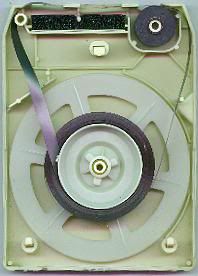
Think about pulling the tape from the center of the reel and them putting it back on the outside of the reel. You should instantly recognize that you are pulling the tape off of a little reel and putting it back onto a bigger reel. The problem is that there is only one reel, and it moves at a constant speed. This caused the problem of making the tape tighter and tighter over time. It happened gradually, but tapes would eventually tend to lock. Many a time I have fixed a cartridge with a relatively simple trick: Pull a few inches of tape from the takeup side of the reel (the outside) and let it back. That almost always did the trick.
Now, think about pulling the tape from the center. To do that, you have to slide the innermost loop past the one just outside of that. Tape is pretty slick, but not that slick. A lubricant was used on the nonrecorded side of the tape to make it slide easier. Many times I had blackened hands after opening up a tape to operate on it, from the graphite lubricating coating. With time, the lubrication would wear off, making the tape essentially unplayable, if something else did not do it in first.
The spalling of the lubricant also would dirty the play heads fairly rapidly. A bottle of alcohol and long cotton swabs were denizens of many glove boxes, and I remember having to clean the heads quite often. Worse than that, this would build up on the capstan, causing the tape to play unevenly in the sense that one edge of the tape was pulled faster than the other edge, the faster side where the buildup on the capstan was. The capstan is just the metal rod that pressed the tape onto the pinch roller. It rotates at a constant speed, so if one end of it has more buildup than the other, wow and flutter would increase. If the capstan gets an even coating, the pitch of the entire tape increases since it is being pulled faster. The swab and alcohol solution usually worked for that, too.
An untreatable condition was in players that had so much use that the capstan acutally wore down somewhat. In this case, the tape would run more slowly than it should have. There is no cure other than a new capstan. I never had that problem, and I think that it pretty theoretical rather than factual, at least in most cases.
The real weak point in the eight track system was the heads in the player. To make the system work, the heads have to advance with each pass of the tape, as mentioned before. The problem is that each time that the heads advanced, they got a little knocked off of the position where they should have been. After some time, the misalignment became so great that you would begin to hear crosstalk betwixt the different programs, and then you had to take a small screwdriver and realign the heads to put them back into their proper position. I do not know if all players had an adjustment screw, but the ones that I had did.
The eight track, while extremely popular, began to suffer from improved cassette tapes and players. In 1971 the first true high fidelity cassette system was developed, but due to expense were not immediately a threat to the eight track tape. By the late 1970s cassettes were becoming cheap and popular, and were much more reliable than the eight track system. One reason was that with two reels, all of the trouble arising from the Mobius strip design were overcome.
Another reason is that the heads did not have to move for cassettes. You simple took out the tape and turned it over, bringing the other program in alignment with the heads (some up scale models had “auto-reverse”, where the player would automatically change the direction of the tape, passing it over a second set of heads, still not requiring any head movement.
Another feature that favored cassettes was the ability to rewind or fast forward them. Some upscale eight track players had the ability to fast forward the tape, but it is fundamentally impossible to rewind the Mobius strip design. By 1982 the eight track tape was pretty much gone from commercial distribution, having been supplemented by cassettes and then, in that year, the compact disc. Likewise, the cassette has pretty much been replaced by the compact disc.
The compact disc is rapidly being replaced by digital downloads, and sales of compact discs are already falling even though music sales are still strong. Thus goes the progress of technology.
Since on a different evening I am The Geek, I must point out that both eight track and cassette tapes are ordered access devices, meaning that to get from one song to another, you have to pass the tape over the read heads until you get to the spot that you want. Compact discs and vinyl records, for that matter, are random access devices, meaning that you can skip to the song that you want by picking up the tone arm of a phonograph, or advancing to the next track on a compact disc. Digital devices are pretty much the ultimate random access devices.
Another disadvantage for eight track tapes was their physical size. Here is a picture of one of mine.
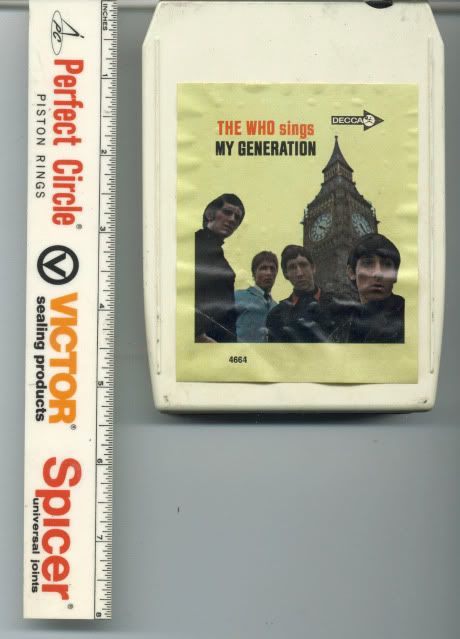
Note that it is around five and a half inches long and more than half that wide. You can not tell from the picture, but it is also about 7/8 inch thick.
Here is a picture of my ancient and beat up eight track tape carrier.
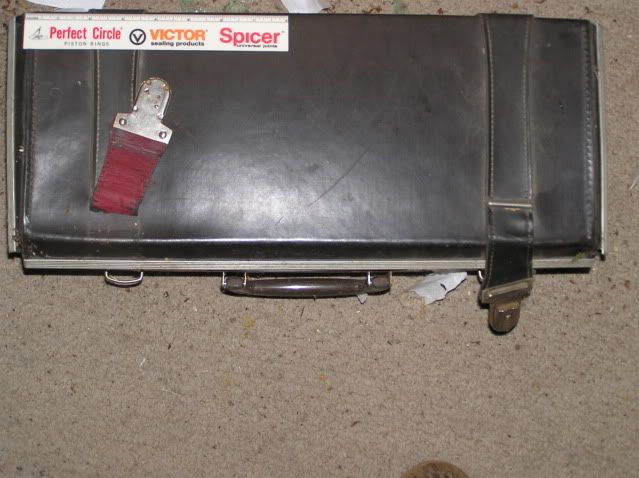
It measures around 20 by 8 by 6 inches, and as you can see from the next picture, hold 24! tapes. In contrast, at 4 by 2 1/2 by 0.25 inches, one could fit around 288 into the same volume, assuming a 25% padding area.
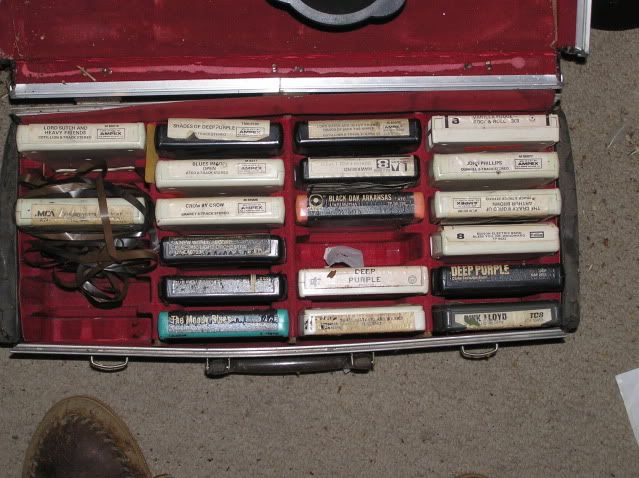
Here is a picture of my CD carrying case, and at 11 by 6 1/2 by 2 1/4 inches holds 48 compact discs. With digital storage, a device the size of a pack of cigarettes can hold thousands of albums. Things change, and rapidly.
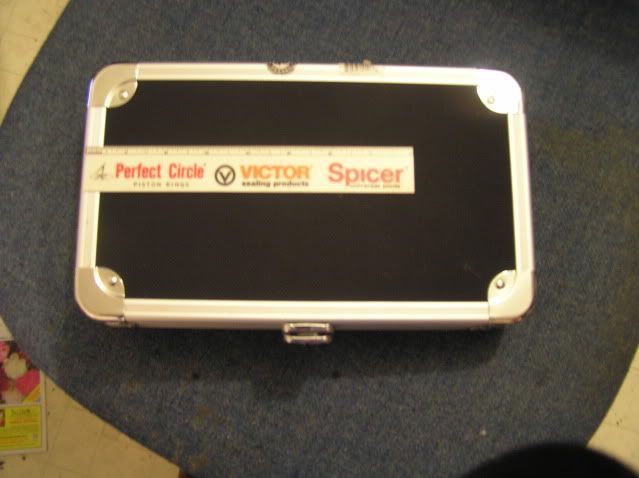
I hope that you have enjoyed this stroll through memory lane. The eight track cartridge and player were an integral part of my life when I was of many fewer years than now, and I still have the tapes although not a player anymore. Before I got a proper stereo, I would take my eight track player into the house (I had a modular design, such that I could use alligator clips to attach and detach it electrically from the car), along with the medium quality speakers that sat on the back seat of my 1967 Camaro. I could clip it onto a 12 volt lawn mower battery and have tunes inside as well!
Warmest regards,
Doc

1 comments
Author
long forgotten music formats?
Warmest regards,
Doc